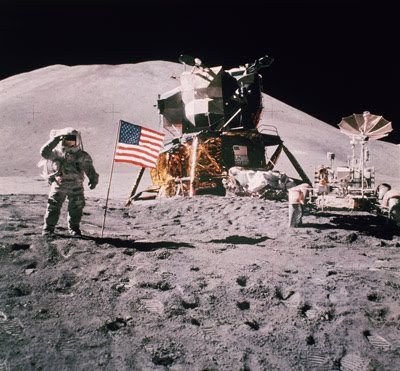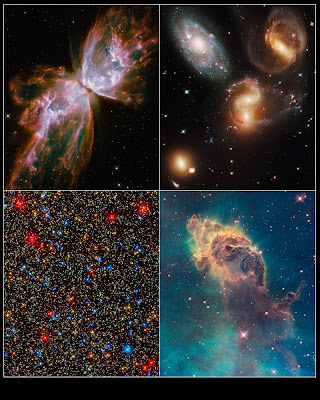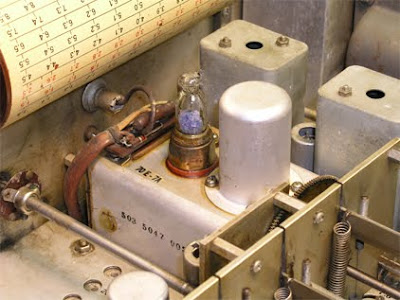 Once again great things are happening in the underground lab of Michael, AA1TJ. Michael has temporarily put aside his work on Iron Pyrite-based receivers, and is now working the world with 50's era point contact transistors. I can feel the enthusiasm, even all the way over here in Rome. I particularly liked Michael's description of the QSO in which the other guy heard his backwave. Backwave is the very small signal that is sometimes put out when the key of simple transmitter is up. For example, the oscillator on my old VXO-controlled 6 watter (from "QRP Classics") ran all the time -- I just keyed the amplifiers. Sometimes guys would report hearing some of the RF from the oscillator even when the key was up. (By the way, the term backwave reminds me of a word used sometime by Billy and Maria: backwash. As in, "No Maria, you can't have a sip of my soda -- you always leave backwash!")
Once again great things are happening in the underground lab of Michael, AA1TJ. Michael has temporarily put aside his work on Iron Pyrite-based receivers, and is now working the world with 50's era point contact transistors. I can feel the enthusiasm, even all the way over here in Rome. I particularly liked Michael's description of the QSO in which the other guy heard his backwave. Backwave is the very small signal that is sometimes put out when the key of simple transmitter is up. For example, the oscillator on my old VXO-controlled 6 watter (from "QRP Classics") ran all the time -- I just keyed the amplifiers. Sometimes guys would report hearing some of the RF from the oscillator even when the key was up. (By the way, the term backwave reminds me of a word used sometime by Billy and Maria: backwash. As in, "No Maria, you can't have a sip of my soda -- you always leave backwash!") In his e-mails, Michael mentions that the physics of the point contact devices are a bit of a mystery for him. I recall that the book "Crystal Fire" by Riordan and Hoddeson had some pretty good info on how these early transistors worked.
Here are some excerpts from Michael's e-mails on this project:
I haven't had time to document this pyrite/tunnel diode receiver on account of a phone call that I had two weeks ago from Jack Ward at the Transistor Musuem. Jack approached me with an idea to recreate the first ham radio contacts using transistors. Of course, the point-contact transistors involved are now pretty rare items. No problem for a fellow with a transistor museum though!
Jack kindly sent me a couple of Western Electric, 2N110 "relics." I had some initial trouble with "squegging," and I wasn't able to produce oscillation above 380kHz. To read a recent tale of one fellow's trouble trying to tame the 2N110, please see
I especially liked where he wrote, "I did seriously consider giving up at this stage and taking up heavy drinking." ;o)
However, I located an old textbook that discussed circuit design theory using point-contact transistors (the physics of these devices are still clouded in mystery). What I learned made all the difference. A few more hours at the bench and I had an 80m transmitter putting out 10mW.
The story gets better though, Ned. A circuit briefly described in another old book really caught my attention. It was pretty much the same circuit as was used by George Rose, K2AH, in his first transistor QSO. Only, a circuit (designed by G3IEE) showed a pair of headphones in dotted lines, next to the collector resistor. The text merely said
"As indicated, the circuit also functions as an oscillating detector type of receivere for local continuous wave operations whith head phones plugged into the collector circuit instead of resistor R3. Good reception and break-in operation were obtained."
That got my blood moving! Positive results came right away on the bench. The received signals were every bit as strong as with my Reggie and the Cub Scout heterodyne (what I started calling, "Chester," after the name of the mine where the pyrite was found).
I had my first QSO last week using Jack's point-contact transistor (made in 1956) in the transceiver designed by G3EII (in 1954). Jim, W1PID, was my first contact. Since then I've made over a dozen QSO's with five different stations.
FYI, I'll paste a message below that I sent to Jack Ward this weekend. One thing I forgot to add is that W1VZR copied my 10mW signal on his Cake Pan regenerative receiver over in Maine last week. Aside from my three QSO's with VE3DJX at a distance of 319 miles, the other notable results to-date were hearing both W1DFU and W1PID - in the course of separate QSOs - when they dropped down to an output power of 100mW.
Again, I haven't had a chance to post much on my web site, but I do have the current schematic up, and you can see both K2AH and G3IEE's circuits in scans from the old transistor book. G3IEE's circuit is shown in Figure 16.2 in the second jpeg image.
One more thing, Ned. I hooked up this past week with G3JNB. Victor was one of the fellows (he was only 21 at the time) working with Tony, G3IEE, back in 1954 to make the first-ever, UK ham radio QSOs using transistors. Victor has already posted an envelope containing copies of his log, the QSL card from G3IEE and the original, 1954, Wireless World article describing their results. In the course of our Skype video call last week, Victor held up to the camera the RAF telegraph key that he used for his QSO with Tony. Pretty neat, eh?
I've got to get back to work here. Congratulations on getting your Reggie up and running, Ned. I look forward to seeing the photos and I'd surely like to hear about any contacts you make with it. Speaking of which, I have some photos of Jim, W1FMR's beautifully constructed Reggie that I've been meaning to post on my web page. Once I get around to it would you mind if I include one of your photos as well?
Best wishes,
Mike, AA1TJ
Hi Jack,
Yes, I had great fun with our little 2N110's this past week. Of of now, I've had well over a dozen radio contacts with five different stations. I used 10mW of output power to make these contacts. The distances shown are all "as the crow flies."
W1PID, Sanbornton, NH, 67miles; lowest power used on his end 100mW
VE3DJX, Smith Falls, Onatario, 319 miles; 10watts on his end
W1DFU, Wallingford, VT, 42 miles; his lowest power was 100mW
W1VZR, Limerick, ME, 100 miles; 40w
Pete, the last fellow listed, heard the 2N110 while it was running as a "beacon" with a continuously looped Morse code message. Having received my call-sign he located my email address and shot off a reception report. I saw his message pop up on my computer and quickly looked up his telephone number. He was still at his radio when he picked up the phone. I found him pretty excited as my signal strength had sharply risen in the last few minutes. He asked if there was a problem with my keying circuit as he could still hear a faint tone on my frequency when my transmitter should have been silent. "Ha!" sez I, "You're hearing a 100 microwatt back-wave radiation!" The distance separating us divided by the 100uW power is equivalent to 1 million miles per watt; a very impressive figure!
One more station answered my CQ this past week from near Hartford, CT. However, I can't recall his call sign and I'm currently at work but my logbook is at home. My output power was up to 17mW during that contact; on account of a temporary change that I made to the circuit. However, pushing the transistor to that power level reduced the quality of the keying, and so I returned to 10mW following that contact (earlier, I'd reported that my output power was 12mW, but a more careful measurement indicated that I was only putting out 10mW).
You might have noticed that I've posted the schematic to my web site. However, I expect the circuit will change over the next week, or so, as I still want to tinker with the keying circuit. By all reports my signal is good but it has just a touch of keying "chirp." Chirp is what hams call a variation in the received signal tone when the telegraph key is first depressed. Again, I expect to have that sorted out before long.
Yes, it was a real pleasure talking with Victor, G3JNB. FYI, I'll send you copies of all the documents that he provides. He said that he's including some original data sheets for point contact transistors that he's held on to these past 55 years. I'll keep copies and send the originals to you.
I asked Victor if he'd like me to build a duplicate radio for him using the second 2N110 that you sent me. I think he was thrilled to hear my offer. Don't you think it would wonderful if he, of all people, managed to make a contact using a reproduction of the point-contact transmitter that he and Tony, G3IEE, used in those pioneering days?
The order of business next week is to finalize the circuit design and begin building two identical circuits into permanent radios. Of course, I'll take time off, now and then, to try and make more contacts. I'm already astonished that it was possible to span a distance of 319 miles (not once, but thrice!) using your ancient transistor relic.
Acting on your suggestion, I looked up the other fellows mentioned in K2AH's article. It turns out that Tommy Thomas, W2UK, was quite a radio pioneer on VHF.
http://www.infoage.org/html/p-43W2uk.html
Unfortunately, I've learned that he passed away not so long ago. The call signs of the other two fellows are not currently in the FCC database (I suspect because they are gone as well). A quick search on the Internet turned up nothing on them.
Victor, G3JNB, remarked that he believes that he is the only one left of his original group of transistor enthusiasts. Doubtless, one reason is that he was only 21 years-old at the time of the experiments with G3IEE.
Victor reports that Tony, G3IEE, worked as an engineer for Mullard. I guess that explains where his transistors came from. Victor used a standard vacuum tube transmitter for his first contact with Tony, but sometime later he built his own one-transistor transmitter following Tony's design. Victor says that he used it to make one or two contacts across town before he put it on the shelf. Again, I'll be very interested to see the photocopy of his station log from that period.
One more thing, Jack. I'm fortunate to count George, G3RJV as a pal-o-mine. George is a recently retired Anglican vicar, but he also founded the GQRP; what began as a society of UK amateurs interested in low power operation. Since then, it has become something of an international institution. I had a message of congratulations this week from George; saying that he's keeping a watchful eye on our project. In return, I inquired if George might be able to put me in contact with folk that might help shed light on what was going on at that time (transistor-wise) in the rest of "Hamdom". That is, I'd like to assemble a folder on the topic of "first transistor QRP QSOs" for Japan, Western and Eastern Europe, Australia, etc.. I'll keep you apprised of any news.
That's all from here, Jack. Once again, I'd like to express my thanks to you for including me in your project. It's already been great fun and a real pleasure to meet some wonderful people.
Kind regards,
Mike, AA1TJ
Yes, I had great fun with our little 2N110's this past week. Of of now, I've had well over a dozen radio contacts with five different stations. I used 10mW of output power to make these contacts. The distances shown are all "as the crow flies."
W1PID, Sanbornton, NH, 67miles; lowest power used on his end 100mW
VE3DJX, Smith Falls, Onatario, 319 miles; 10watts on his end
W1DFU, Wallingford, VT, 42 miles; his lowest power was 100mW
W1VZR, Limerick, ME, 100 miles; 40w
Pete, the last fellow listed, heard the 2N110 while it was running as a "beacon" with a continuously looped Morse code message. Having received my call-sign he located my email address and shot off a reception report. I saw his message pop up on my computer and quickly looked up his telephone number. He was still at his radio when he picked up the phone. I found him pretty excited as my signal strength had sharply risen in the last few minutes. He asked if there was a problem with my keying circuit as he could still hear a faint tone on my frequency when my transmitter should have been silent. "Ha!" sez I, "You're hearing a 100 microwatt back-wave radiation!" The distance separating us divided by the 100uW power is equivalent to 1 million miles per watt; a very impressive figure!
One more station answered my CQ this past week from near Hartford, CT. However, I can't recall his call sign and I'm currently at work but my logbook is at home. My output power was up to 17mW during that contact; on account of a temporary change that I made to the circuit. However, pushing the transistor to that power level reduced the quality of the keying, and so I returned to 10mW following that contact (earlier, I'd reported that my output power was 12mW, but a more careful measurement indicated that I was only putting out 10mW).
You might have noticed that I've posted the schematic to my web site. However, I expect the circuit will change over the next week, or so, as I still want to tinker with the keying circuit. By all reports my signal is good but it has just a touch of keying "chirp." Chirp is what hams call a variation in the received signal tone when the telegraph key is first depressed. Again, I expect to have that sorted out before long.
Yes, it was a real pleasure talking with Victor, G3JNB. FYI, I'll send you copies of all the documents that he provides. He said that he's including some original data sheets for point contact transistors that he's held on to these past 55 years. I'll keep copies and send the originals to you.
I asked Victor if he'd like me to build a duplicate radio for him using the second 2N110 that you sent me. I think he was thrilled to hear my offer. Don't you think it would wonderful if he, of all people, managed to make a contact using a reproduction of the point-contact transmitter that he and Tony, G3IEE, used in those pioneering days?
The order of business next week is to finalize the circuit design and begin building two identical circuits into permanent radios. Of course, I'll take time off, now and then, to try and make more contacts. I'm already astonished that it was possible to span a distance of 319 miles (not once, but thrice!) using your ancient transistor relic.
Acting on your suggestion, I looked up the other fellows mentioned in K2AH's article. It turns out that Tommy Thomas, W2UK, was quite a radio pioneer on VHF.
http://www.infoage.org/html/p-43W2uk.html
Unfortunately, I've learned that he passed away not so long ago. The call signs of the other two fellows are not currently in the FCC database (I suspect because they are gone as well). A quick search on the Internet turned up nothing on them.
Victor, G3JNB, remarked that he believes that he is the only one left of his original group of transistor enthusiasts. Doubtless, one reason is that he was only 21 years-old at the time of the experiments with G3IEE.
Victor reports that Tony, G3IEE, worked as an engineer for Mullard. I guess that explains where his transistors came from. Victor used a standard vacuum tube transmitter for his first contact with Tony, but sometime later he built his own one-transistor transmitter following Tony's design. Victor says that he used it to make one or two contacts across town before he put it on the shelf. Again, I'll be very interested to see the photocopy of his station log from that period.
One more thing, Jack. I'm fortunate to count George, G3RJV as a pal-o-mine. George is a recently retired Anglican vicar, but he also founded the GQRP; what began as a society of UK amateurs interested in low power operation. Since then, it has become something of an international institution. I had a message of congratulations this week from George; saying that he's keeping a watchful eye on our project. In return, I inquired if George might be able to put me in contact with folk that might help shed light on what was going on at that time (transistor-wise) in the rest of "Hamdom". That is, I'd like to assemble a folder on the topic of "first transistor QRP QSOs" for Japan, Western and Eastern Europe, Australia, etc.. I'll keep you apprised of any news.
That's all from here, Jack. Once again, I'd like to express my thanks to you for including me in your project. It's already been great fun and a real pleasure to meet some wonderful people.
Kind regards,
Mike, AA1TJ












































